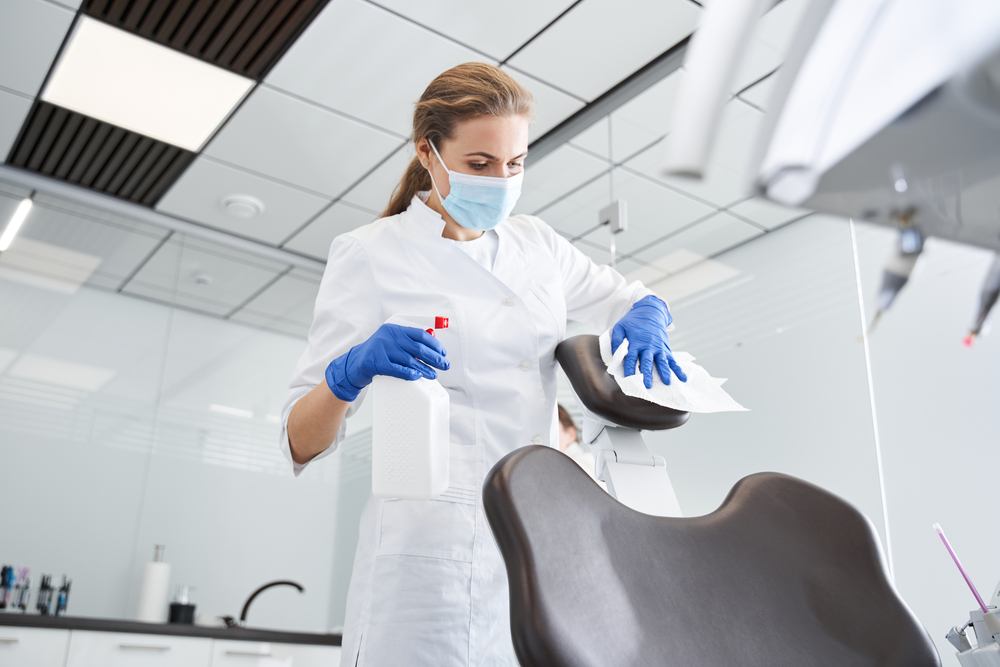
Dental infection control coordinators play a vital role in patient and staff safety and quality of care. Here are five essential steps you need to know.
Print & Go GuidanceBy Sharon Boyd, MA, RDH
According to the CDC, every dental office should have at least one staff member who is trained in infection prevention and responsible for coordinating an infection control program in their clinic. While this task may seem significant, most formally trained dental clinicians and seasoned staff can take on this responsibility. The key is to know which areas need to be addressed and ensure that proper documentation and training are performed.
1. Create a Written Office Infection Control Plan
OSHA requires that dental offices have a documented source outlining office policies and procedures regarding employee exposure, sharps safety, and disinfection protocols. This includes needlestick protocols and eye-washing stations, office policies regarding equipment, and personal protective equipment use. While this source can be curated in-office, you can outsource the project to an OSHA consultant or cross-reference guidelines provided through professional organizations, such as the CDC's Infection Prevention & Control Guidelines & Recommendations for dental offices. These written plans should be updated annually.
In addition to maintaining a written infection control plan, office coordinators should document Material Safety Data Sheets (MSDSs) as part of their OSHA records.
2. Ensure Proper Safety Equipment is Available and Utilized

Appropriate Personal Protective Equipment (PPE) should be readily available for all staff potentially at risk of coming into contact with bloodborne pathogens. The infection control coordinator should ensure appropriate staff has adequate PPE, including protective eyewear and properly sized gloves. A classic mistake many dental practices make is failing to wear the correct type of gloves to protect themselves from sharps during sterilization. Part of this educational process should include clinically appropriate hand hygiene and cough etiquette.
Staff should use standard precautions on all patients, regardless of their known health conditions. PPE should be used even if it is assumed that a patient is entirely healthy. Unfortunately, many people may not know or be unwilling to disclose their medical conditions. In fact, as many as 1-in-7 people living with HIV don't even know they're infected.
3. Educate Staff on Disinfection and Cross-Contamination
All staff should be trained on proper hand hygiene, handling contaminated instruments, and surface disinfection in clinical rooms. This includes appropriate levels of sterilization and sanitation for instruments, countertops, and equipment that comes into contact during the patient care process. For example, non-critical items can be covered with a barrier and disinfected, while critical instruments must be heat sterilized. Basic infection discussions should include how materials are handled and cleaned and how to don and remove PPE safely.
4. Establish a Sterilization Monitoring Process
Known sterilization practices go back to the second century AD when Greek physicians boiled their instruments while treating Roman gladiators who had been wounded. Today, we can monitor sterilization equipment's effectiveness through mechanical, biological, and chemical monitoring. Dental offices should conduct biological monitoring weekly and maintain documentation of test findings.
In addition to monitoring sterilization procedures, the infection coordinator should also evaluate the water quality in the dental units to ensure they meet EPA standards.
5. Perform Annual Staff Training and Maintain Documentation
New dental staff should complete infection control training during their onboarding process. Additionally, all staff should receive refresher training every year. Some areas where training is required include sterilization processes, OSHA bloodborne pathogens standards, and proper use of PPE. Bloodborne pathogen training is usually conducted through a certified third-party course provider; staff receive a completion certificate which should be kept in their file.
In addition to documentation of staff training, dental practices should encourage staff members to maintain or complete immunizations such as the Hepatitis B vaccine, keeping a record in their personnel file.
Where to Start
As a new infection control coordinator, the first thing to do is draft your written office infection control plan. By including the above steps in your written procedural manual, you can work more efficiently by training staff on PPE, sterilization, room disinfection, cross-contamination, and collecting appropriate documentation. If you are new to the role of infection control coordinator, you can find a helpful checklist provided by the CDC designed explicitly for dental settings HERE. By following resources such as these and ensuring that all staff members are trained—and re-trained each year—on proper infection control and sanitation procedures and maintaining proper documentation, you can establish a new program and easily maintain system oversight from year to year.
If you're not yet subscribed to receive the Incisor newsletter, filled with cutting-edge dental news sent directly to your inbox twice a month, you can do so here.
Sharon Boyd, MA, RDH — Sharon has over 20 years of experience in the dental industry and is the founder of DentaSpeak, LLC. In addition to being a registered hygienist, she serves as a full-time patient education professional with a special interest in strategic dental communications. She often works as a liaison between practitioners and patients, bridging the gap between care needs and patient concerns. Sharon is an Ironman, band mom, and enjoys volunteering at her family's church.




